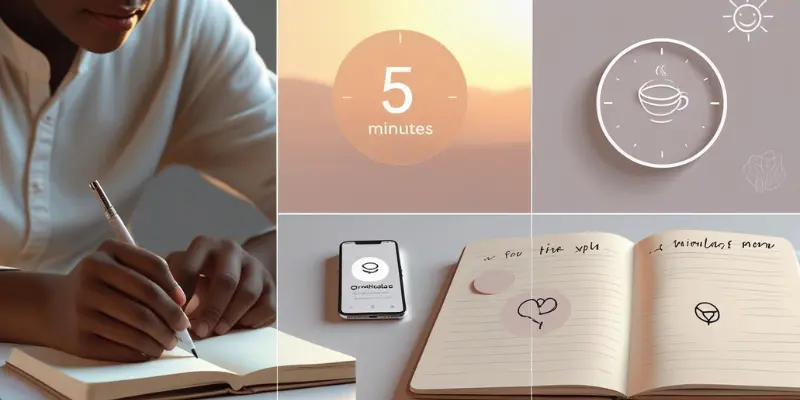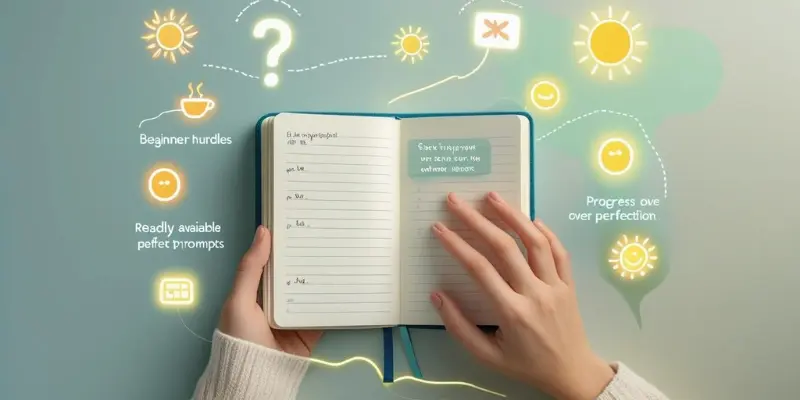How to Start a Gratitude Journal for Beginners: Your Easy 5-Minute Daily Guide
Published: 10/07/2025
Have you ever felt like life is moving too fast, leaving you overwhelmed by to-do lists and constant demands? You’re not alone. Many of us juggle work, family, and everything in between, often feeling like we’re running on empty. But what if I told you that in just five minutes a day, you could create a small habit that could drastically change your mindset?
Gratitude journaling is a simple, powerful tool that can help shift your focus from the chaos to the good in your life. In this easy-to-follow guide, you’ll learn how to start your gratitude journal with just five minutes a day. No fancy journals, no complicated rules—just a space to reflect on what’s going well and what you’re thankful for.
Imagine starting your day with a sense of calm or ending it with a smile, knowing that you’ve taken time to focus on the positive. By the end of this post, you’ll not only understand how gratitude journaling works but also see how this small habit can reduce stress, improve your mood, and help you build stronger relationships.
So, why not give it a try today? Grab a notebook, or open your phone, and let’s get started with your very first entry. You might just discover a whole new way of seeing the world.
What Exactly is a Gratitude Journal (and Why Start One)?
A gratitude journal is a simple yet powerful tool that allows you to focus on the things in your life that you are thankful for. It’s not about writing perfect sentences or crafting elaborate paragraphs—it’s about setting aside a moment each day to reflect on the positive moments and experiences that bring you joy. Whether it’s a warm cup of coffee in the morning, a kind word from a friend, or simply a peaceful moment, a gratitude journal is a dedicated space where you note these small blessings.
More Than Just a Diary: The Core Idea
A gratitude journal is different from a regular diary. While a diary may focus on documenting daily events or emotions, a gratitude journal zooms in on the positive aspects of your day, no matter how big or small. It’s a way to shift your focus from stress, worries, or challenges to the things that bring you comfort and joy. And the best part? It’s not about crafting perfect sentences—it’s about the act of consistent reflection. Even on the busiest days, jotting down just a few things you’re thankful for can make a big difference.

The Transformative Benefits: Why This 5-Minute Habit Matters
Taking just 5 minutes a day to practice gratitude journaling can bring tangible benefits to your mental and emotional well-being. Here’s how this simple habit can transform your life:
- Reduced Stress & Anxiety: Shifting your focus to the positive things in your life can help calm your mind, reduce feelings of overwhelm, and lower stress levels.
- Increased Happiness & Optimism: Studies in positive psychology show that practicing gratitude regularly can lead to greater happiness and a more optimistic outlook on life.
- Improved Sleep Quality: A positive mindset at night, cultivated through gratitude, can help you relax and improve your quality of sleep.
- Enhanced Resilience: By regularly reflecting on what you’re thankful for, you strengthen your ability to cope with life’s challenges, making you more resilient during tough times.
- Stronger Relationships: Noticing and appreciating the contributions of others deepens your connections, whether with friends, family, or colleagues.
- Greater Self-Awareness & Self-Compassion: Practicing gratitude allows you to become more mindful of your strengths and progress, fostering a greater sense of self-compassion and understanding.
Getting Started: Your Simple 5-Minute Daily Gratitude Routine
Starting a gratitude journal is easier than you might think. In just 5 minutes a day, you can introduce a habit that can transform your mindset, reduce stress, and boost your happiness. Here’s how you can get started in just a few simple steps.

Step 1: Choose Your Journal (Physical or Digital?)
The first step is choosing a place to record your thoughts. The good news? It doesn’t need to be fancy! Whether you prefer the feel of pen on paper or the convenience of your phone, there are plenty of options to fit your style:
- Simple Notebook: Any notebook will do! You don’t need a special journal—just something that feels comfortable and easy to use.
- Dedicated Gratitude Journal: If you’d like something designed specifically for gratitude journaling, there are plenty of options available, but this is optional.
- Phone App: If you prefer digital, many apps allow you to jot down your thoughts quickly and carry your journal with you wherever you go.
- Word Document: For those who like typing, a simple document on your computer can work perfectly.
The key here is choosing something that’s accessible and comfortable for you. Don’t worry about making it perfect or fancy—just focus on starting.
Step 2: Pick Your Perfect Time (Consistency is Key)
Now that you have your journal, the next step is figuring out when to write. The beauty of gratitude journaling is that it can fit into your routine at any time. What’s most important is consistency, so pick a time that works for you:
- Morning: Write first thing to set a positive tone for the day ahead.
- Evening: Reflect on your blessings and unwind before bed.
- Lunch Break: Even 5 quiet minutes during your break can be enough to jot down a few thoughts.
The main point is to choose a time you can stick with consistently. It doesn’t matter when, just make it a part of your daily routine.
Step 3: What to Write About? (Easy Prompts for Beginners)
This is where many beginners get stuck, but it doesn’t need to be complicated! Start small and focus on 3-5 things you’re grateful for—no need to write long essays or big philosophical reflections. It’s about taking a moment to notice the simple joys in your life:
- Examples:
- What’s one small thing that made you smile today?
- Who are you grateful for, and why?
- What simple pleasure did you enjoy recently? (e.g., a warm cup of tea or a favorite song)
- What about nature are you grateful for today? (e.g., the sunshine or a walk in the park)
- What personal strength are you thankful for? (e.g., patience or resilience)
Here’s a beginner-friendly prompt list to get you started:
- What was the best part of your day?
- Who made your day better today?
- What small thing are you grateful for today?
- What part of your routine are you thankful for?
- What made you feel at peace today?
Step 4: Keep it Simple, Keep it Short (The 5-Minute Rule)
Remember, the key to making gratitude journaling a habit is simplicity. Commit to spending no more than 5 minutes each day. This isn’t about writing perfect grammar or long paragraphs—it’s about the act of noticing and reflecting on what you’re grateful for. Just jot down a few quick thoughts, and don’t worry if it’s not perfect. Keeping it short helps you build a consistent habit without feeling overwhelmed by the task.
Common Beginner Questions & Troubleshooting (Overcoming Hurdles)
Starting a new habit can be tough, and it’s totally normal to encounter a few bumps along the way. Whether you’re struggling with what to write, missing a day, or wondering if your gratitude entries need to be perfect, we’ve got you covered. Here are some common questions beginners often have—and practical solutions to help you stay on track.

“What if I can’t think of anything to write?”
If you’re feeling stuck, don’t worry! You don’t need to come up with something big or profound every time. Sometimes, the smallest details can make the biggest impact:
- Think about the little things: Maybe it’s the warmth of your blanket, the smell of fresh coffee, or the fact that you have clean water to drink.
- Use the prompts: Check back to the prompts provided earlier—they’re designed to help you spot simple joys in your day.
- Look around you: What’s right in front of you? Maybe it’s a plant on your desk or the sound of birds outside your window. Use your senses—what do you see, hear, smell, taste, or feel?
The key is to focus on noticing the small things around you. The more you practice, the easier it gets!
“What if I miss a day (or a week)?”
It happens. Life gets busy, and sometimes you might miss a day (or even a week). Here’s the good news: It’s okay!
- Don’t let the pressure of perfection stop you from continuing. Remember, gratitude journaling is about consistency, not perfection.
- Pick up where you left off: When you do get back to it, just start again. Don’t worry about catching up—focus on the present moment and what you’re thankful for today.
- Focus on consistency: The goal is to make this a regular part of your routine, even if it’s just for 5 minutes a day. One missed day doesn’t undo your progress!
“Do I have to write about big things?”
Nope! In fact, small things are often the most impactful. Gratitude journaling is all about noticing the blessings in your daily life, no matter how small they may seem.
- It could be the sunshine on your face, a smile from a friend, or a quiet moment with your favorite book. The power of gratitude comes from recognizing and appreciating the little things that we often overlook.
Even the tiniest moments of joy can make a huge difference in how you feel. Start small and let the habit build from there.
“Can I write about negative things?”
Gratitude journals generally focus on the positive, but that doesn’t mean you can’t find gratitude in difficult situations. If you’re facing challenges, it’s okay to acknowledge them—but try to focus on the positive outcomes:
- What have you learned?
- How have you grown?
- What strength have you discovered in yourself?
For example, if you’ve had a tough day, you could express gratitude for the resilience you showed, or for the lesson learned in the process. The focus should always be on the positive aspects that arise from difficult situations.
Making Gratitude Journaling a Lasting Habit
Building a new habit takes time, but once you’ve started, it’s all about finding ways to keep the momentum going. Here are some simple yet effective strategies to make gratitude journaling a consistent and lasting part of your daily routine.
Set a Reminder
One of the easiest ways to stay consistent is by setting a reminder for yourself. Out of sight, out of mind is a common issue when starting a new habit, but a gentle nudge can help:
- Use an alarm or calendar notification: Set a daily reminder to write in your gratitude journal, whether that’s in the morning or before bed.
- Link it to an existing habit: Integrating your journaling into something you already do daily (like after brushing your teeth or before your morning coffee) makes it easier to remember and fit into your routine.
The key is making gratitude journaling part of something that already feels automatic.
Re-Read Your Entries
Every once in a while, take a moment to go back and read through what you’ve written. This is more than just revisiting memories; it helps reinforce the positivity you’re cultivating:
- Reflect on how far you’ve come: Looking back at your entries can give you a sense of progress and remind you of the many things you’ve been grateful for.
- Boost your mood: On tough days, reading your journal can lift your spirits and serve as a reminder of the good in your life, even when things feel hard.
Re-reading your entries not only strengthens your habit but also deepens your appreciation for the small things.
Share Your Gratitude (Optional)
Gratitude journaling doesn’t just have to be a personal practice—it can also help strengthen your relationships. If you feel comfortable, take a moment to share your gratitude with someone else:
- Tell someone you’re thankful for them: Expressing your gratitude to others not only makes their day but also reinforces the habit in your own life.
- Strengthen bonds: Sharing gratitude deepens connections and spreads positivity, helping make the practice part of your social routine.
This small act can make your gratitude journaling feel even more meaningful and encourage others to start their own practices.
Be Patient and Kind to Yourself
Gratitude journaling is a journey, not a destination. Some days will be easier than others, and that’s okay:
- Don’t be too hard on yourself: If you miss a day or struggle to write, don’t let it discourage you. It’s about the effort, not perfection.
- Celebrate the small wins: Every time you take the time to reflect on the positives in your life, you’re moving in the right direction.
Remember, it’s the consistency of your practice, not the perfection, that counts.
Beyond the Basics: What’s Next?
Now that you’ve started your gratitude journaling journey, you might be wondering what’s next. The good news is, there’s a lot more to explore! Here are a couple of ways you can deepen and expand your gratitude practice, without feeling overwhelmed.
Exploring Different Journaling Styles
As you become more comfortable with your gratitude journal, you may want to try different styles to keep things fresh and exciting. Here are a few options to consider:
- Themed Entries: Instead of simply writing about anything you’re grateful for, try focusing on a specific theme for the day or week. For example, you could dedicate a week to reflecting on gratitude for relationships, nature, or personal growth.
- Bullet Journaling: If you enjoy organizing, bullet journaling can be a creative way to track your gratitude. You can use bullet points, charts, or even doodles to keep things fun and visual.
These styles can add variety and help you stay engaged with the practice while still focusing on the core idea of gratitude.
Deepening Your Gratitude Practice
Once you’re comfortable with daily journaling, there are a few ways to take your gratitude practice to the next level:
- Gratitude Meditations: Combine your journaling with mindfulness by practicing short gratitude meditations. Take a few moments to sit quietly and reflect on what you’re thankful for before or after journaling.
- Gratitude Letters: Another beautiful way to deepen your practice is by writing gratitude letters. You can express your appreciation to someone who’s made a difference in your life. It’s a wonderful way to not only acknowledge others but also deepen your own feelings of gratitude.
These practices allow you to explore new dimensions of gratitude and make the habit even more meaningful.
Conclusion: Start Your Journey to More Joy Today!
Gratitude journaling is a simple, powerful practice that anyone can start, no matter how busy life gets. In just 5 minutes a day, you can bring more positivity, calm, and joy into your life. It’s not about perfection—it’s about taking a moment to reflect on the things that make your life meaningful, no matter how big or small.
The benefits of gratitude journaling are clear: reduced stress, increased happiness, stronger relationships, and a greater sense of self-awareness. By committing to this daily practice, you’ll begin to notice the positive changes in your mindset and overall well-being.
So, why wait? Grab a pen and paper, or open your favorite journaling app, and start your gratitude practice today. It only takes 5 minutes, but the positive effects can last a lifetime.
What are you grateful for today? Share in the comments below and inspire others to start their own journey to gratitude. Or, if you’ve already started your gratitude journal, tell us your favorite tip for making it a lasting habit!
Your Journey Continues: Common Questions on Gratitude Journaling Answered
For beginners, aiming for just 5 minutes daily is ideal to build a consistent habit. Consistency is more important than duration! Even if it’s only a few times a week, a regular practice will still bring benefits.
The best tool is simply one you’ll actually use. This could be a basic spiral notebook, a dedicated gratitude journal, a simple word document on your computer, or even a notes app on your phone. Don’t overthink it – just choose what feels most convenient and accessible to you.
Absolutely not! You can start a gratitude journal with just a piece of paper and a pen. The practice itself is what truly matters, not the fancy cover or specific layout. A simple, inexpensive notebook is perfectly fine for your journey.
This is a common feeling, especially on tough days! Start with the absolute basics: your breath, the roof over your head, a comfortable chair, clean water. Then look for tiny, everyday joys you might overlook: a sunny window, a warm drink, a favorite song, a kind text message. Sometimes, just recalling a nice moment from the past can help you get started.
Your entries can be as short as a single word or a quick bullet point. For beginners following our 5-minute guide, aim for 3-5 specific things you’re grateful for. A sentence or two explaining why you’re grateful for each item is perfect for deepening the feeling, but don’t feel pressure to write long paragraphs.
Yes, it’s absolutely okay! Life happens, and perfection isn’t the goal here. The most important thing is to simply pick up where you left off without guilt. Don’t let a missed day derail your entire practice. Just return to it when you can, and celebrate that you’re restarting.
Both methods are effective! Digital journaling (using apps, notes, or documents) offers convenience and accessibility on the go. Physical journaling can feel more intentional and mindful for some, offering a tactile experience. Choose the method that you find most comfortable and that helps you maintain consistency.
Writing down your gratitude shifts your brain’s focus from negative worries to positive experiences. This practice can reduce stress hormones like cortisol and boost feel-good chemicals like dopamine and serotonin. It trains your mind to notice the good things around you, which, over time, can rewire your perspective towards more optimism and peace.
Gratitude journaling can be beneficial at almost any age! Children as young as 4 or 5 can begin with simple drawings or dictating things they’re thankful for. For older children and teenagers, it’s an excellent tool for emotional regulation and developing a positive mindset. The key is to keep it fun and simple for their age.
A regular diary often serves as a general record of events, thoughts, and feelings, which can include both positive and negative experiences. A gratitude journal, however, has a very specific focus: intentionally noting and reflecting only on things you are thankful for. Its purpose is to cultivate a positive mindset and appreciation.

- Be Respectful
- Stay Relevant
- Stay Positive
- True Feedback
- Encourage Discussion
- Avoid Spamming
- No Fake News
- Don't Copy-Paste
- No Personal Attacks

- Be Respectful
- Stay Relevant
- Stay Positive
- True Feedback
- Encourage Discussion
- Avoid Spamming
- No Fake News
- Don't Copy-Paste
- No Personal Attacks





